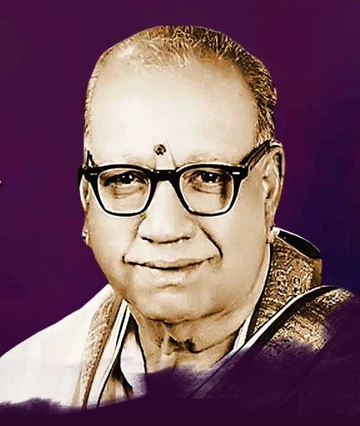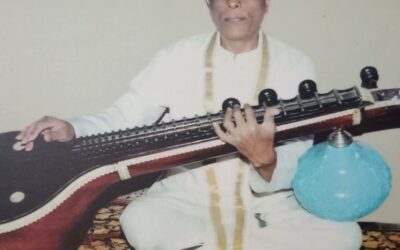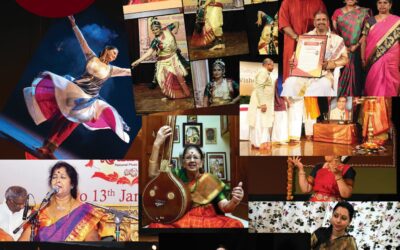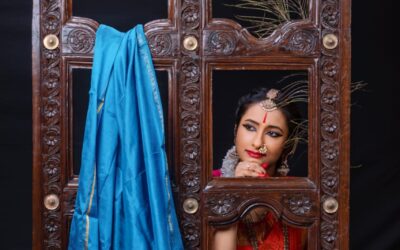From “Murali Vani”, Sri B V K Sastry Felicitation Volume
In Palani and its surrounding areas, his voice and music became before long an attraction for the people, and he was repeatedly asked to give performances: his schooling in laya was possibly achieved in this manner – more on the platform than at the feet of his master in his home. “I cherish the sympathy and understanding of Rangappa Ayyar, which not only gave a perfection to my knowledge of tala and laya, but also made me proficient on the mridangam and the harmonium,” Maharajapuram said to me. “Indeed, I was so grateful that I offered him whatever money I earned by giving performances – and it was goodly sum because I was in high premium already. But he was loth to accept, and I had to press him to take it.”
Even before his apprenticeship with Umayalpuram Swaminath Iyer, Maharajapuram used to sing at public functions. One such recital he remembered was in connection with the Coronation Celebrations of King George V. Though he was not at that time well trained, he had, by his good voice spontaneity and naturalness of expression, already won a host of admirers. Later, after his training under his two masters, his music emerged with a characteristic beauty and finesse. From then on, Maharajapuram was in constant demand, and, though young in years, he found himself in the distinguished class of stalwarts comprising Konerirajapuram Vaidyanatha Iyer, Ramanathapuram Srinivasa Iyengar, Madurai Pushpavanam and Palladam Sanjiva Rao. In fact, he virtually held the field after the passing of Srinivas Iyengar and Pushpavanam and the fading away of Koneriajrapuram from the platform, till the advent of Ariyakudi Ramanuja Iyengar.
Occasionally, however, his voice suddenly would become amenable, unfolding to the listener a magnificent vista that was reminiscent of his best period. Old-timers speak nostalgically of his music and of the vast flights of manodharma that once came to him so easily. They recall with relish the times, when getting his ‘mood’, he would pause on and elaborate on single passages in kritis – instead of singing away the whole – into seemingly infinite variations, in both raga and swara. While his vigorous treatment of such ragas as Arabhi, Darbar and Mohanam enlivened the audience, his sensitive rendering of pieces like ‘Kshinamai’, in Mukhari, and ‘Kshirasagara’, in Devegandhari, would move them to tears. Similarly, the audience would be overawed by his spacious execution of classic ragas like Kambhoji or stately pieces in that mode, like Sri Subramanyaya Namaste”.

Image source: Wikipedia
Speaking of his mastery over Mukhari reminds me the day when he sang the alapana of Mukhari before rendering the Kriti Ksheenamai. Mysore T.Chowdiah was supporting him on violin. After Iyer’s alapana, when the turn of the violin came, he refuse to play stating “Your Mukhari was so divine and inspiring, I would like to retain it in my memory and do not want either to spoil or dilute the effect by my violin playing.
The occasional exotic strain, borne through fanciful flights in his rendition, more ofter suggested a strong impact of Hindustani music. Yet Maharajapuram, though cherishing a high regard for Hindustani music, had not actually cultivated it. But atleast one singer outside the Karnatak fold seemed to hold a special fascination for him – Balgandharva. Maharajapuram had a large collection of this vocalist’s disc-records of stage and devotional songs. It was always a delightful pastime for him to play these records and he had, in fact, memorised many of the songs so precisely as to have startled a North Indian audience, years ago. “My happiness was all the grater when I found that Balgandharva and I received the National Award together,” said Maharajapuram.
Although a product of old times and steeped in tradition, Maharajapuram was not, unlike some other musicians in the field, depressed or distressed over contemporary trends in Karnatak music. Possibly his natural cheerfulness overrided such pessimism. “After all, ignorance of classical traditions in music is not something new. “he would sya. “It existed even before”.
He illustrated the remark with a story from his life. “Once I sang before a reputed patron of the arts in Andhra, accompanied by top instrumentalists I thought he would certainly enjoy the spirit and sentiment behind the compositions of Tyagaraja – which I always prize most – and presented a few of them, stressing the beauty of each sequence and passage. After a while, our host interrupted us and asked: “What has happened to you people?Why is there no fight among you? “We were taken aback. So, reluctantly we finished the latter half of the programme in vocal and swara arobatics, which evidently satisfied our host, considering the generous presents that he made us after the concert.
“Similarly,” said Maharajapuram. “I recall the boasting of a neighbouring lady, a member from the class of the new rich, who spared neither time nor money to make her daughter culturally advanced. “The same man’ said she,’ who teaches my daughter also instructs the girl next door. Today, he said, he would commence teaching Saveri to both. I insisted that he should not teach any ordinary variety to my daughter, but only the pure and the best – Suddha Saveri’ The lady was obviously ignorant of the fact that Saveri and Suddha Saveri are poles apart.” (While Saveri is close to Jogiya in Hindustani music, Suddha Saveri corresponds to Durga.)
“Such stray instances apart, I find that earnest students of music at all times outnumber the ignorant. But the situation and circumstances greatly help the promotion and the maintenance of the classical qualities of this noble art, now drawing sustenance mainly from the works of the trinity -Tyagaraja, Dikshitar and Syama Sastri.”
Incidentally, Viswanatha Iyer was a great devotee of Tyagaraja’s and never missed the annual aradhana celebrations of Tiruvayyar, to offer his homage at the samadhi of the composer. “Tyagaraja’s compositions” observed Maharajapuram, “breathe the very essence of the beauty and spirituality of our noble musical traditions. They are always a source of inspiration and guidance for the cultivation and promotion of music at any time. They underline sadhana and bhakti (preseverance and devotion), the two forces that transcend time and space. As long as they guide future generations, too, I have no fear for the noble traditions of Karnatak music.”
Towards the evening of his life Maharajapuram had no doubt left the best phase of his life behind. As a concession to age, though the pace of his activities had slowed down, he still had the urge to sing and give expression to musical ideas that had attained a mellow maturity. Indeed he was being invited to distant places where there were sizeable sections of his admirers. He was the same rotund and mirthful personality. But the voice had lost its original sparkle and could not present ideas with the same depth of tone and wholesomeness and also sensitivity that were once characteristics of his music. It had developed a dry texture and could attain desired warmth only after considerable time. Thus his music was more ideally suited to small and close gatherings, a sort of chamber music party. Though he was conscious of this fact, Maharajapuram himself was not unduly perturbed over this.
The intesnsity of his devotion to Tyagaraja was so much, he intended to settle at Tiruvayyaru itself where the Samadhi of Tyagaraja is situated and breathe his last very near this monument. Maharajapuram belongs to the shishya parampara of Tyagaraja. Did he take any steps for the continuation of this tradition? We cannot say because he was always a busy musician and more than that by nature he was light hearted and not serious. Nevertheless, he has also contributed his might in this respect where quality supercedes quantity in numbers. His best known disciples are veteran Vidwan Dr.Semmangudi Srinivasa Iyer and Vidwan Maharajapuram Santhanam, the leading lights in the sphere of Karnatak music. True, they inherited the mantle of Maharajapuram Vishwanatha Iyer, but whether they inherited also his style is doubtful because it was so original and individualistic.



